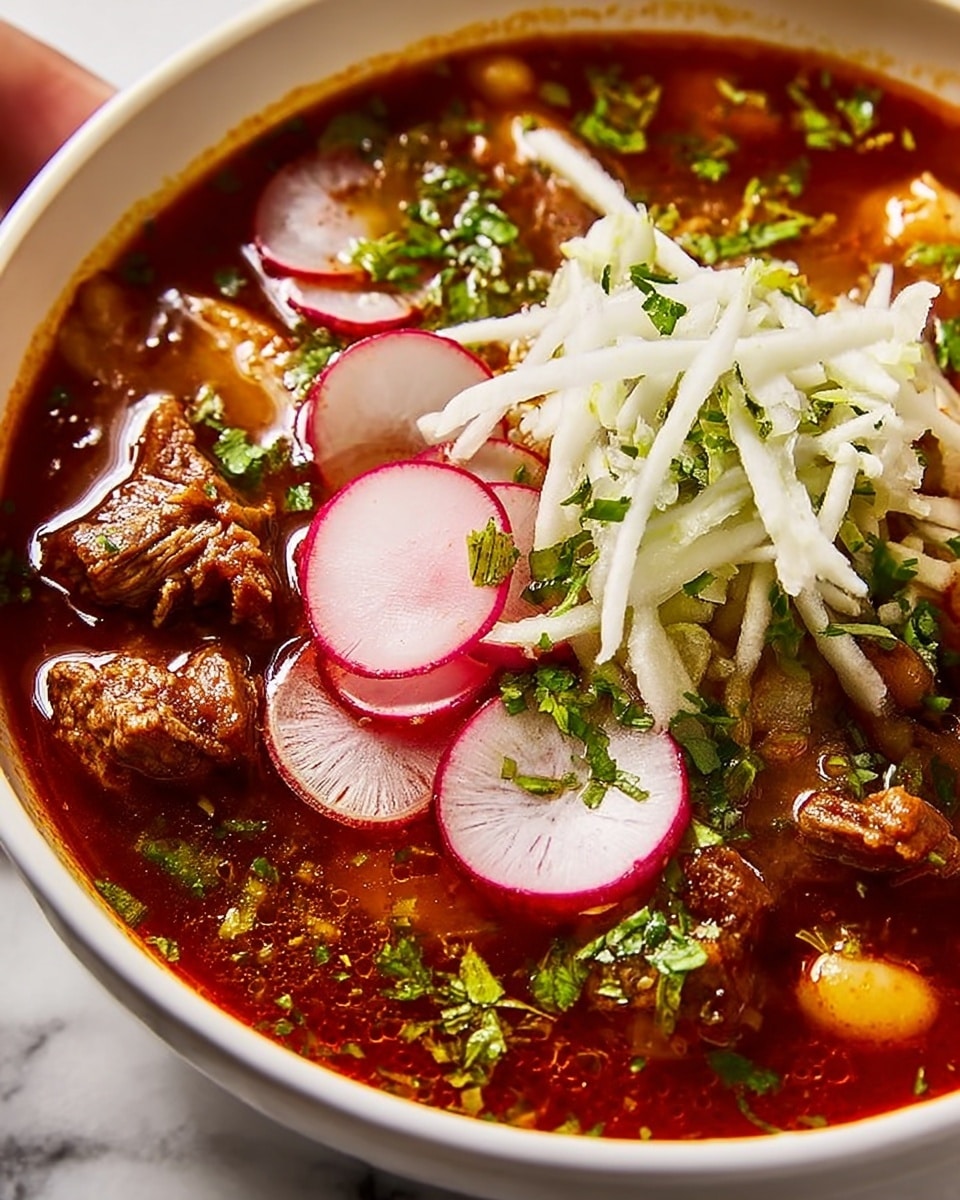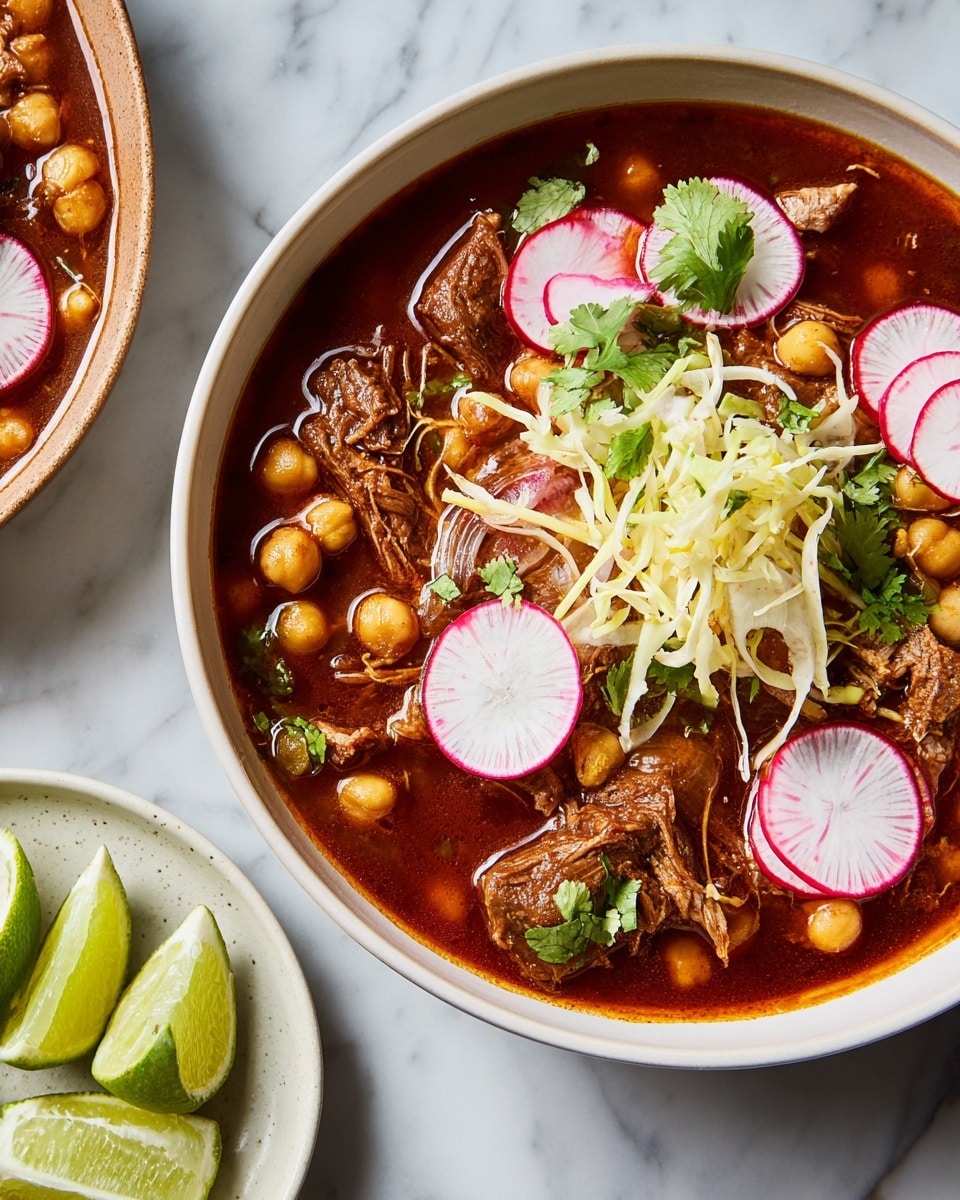If you’ve ever craved a bowl of rich, comforting Mexican stew that warms you from the inside out, then you’re going to absolutely love this Pozole Recipe. It’s one of those traditional dishes that’s easy to make at home but feels like a special celebration every time. Whether you’re cooking for a cozy family dinner or want to impress friends, this pozole hits all the right notes with tender pork, hearty hominy, and deeply flavorful chile broth. Stick with me—I’ll share all my tips to make it simple and delicious in your kitchen.
Why You’ll Love This Recipe
- Authentic Flavor: Using a trio of dried chiles gives the broth a rich, smoky depth you just can’t beat.
- Comforting and Hearty: Tender pork and hominy make it a filling meal that feels like a warm hug.
- Customizable Garnishes: Fresh radishes, cabbage, and cilantro add brightness and crunch, so you can top it exactly how you like.
- Perfect for Sharing: It makes a generous batch, so you’ll have plenty of leftovers or friends to feed.
Ingredients You’ll Need
Before you dive in, it’s good to know why these ingredients work so well together. The pork shoulder gives you tender, juicy meat, while the blend of dried chiles adds smoky warmth balanced by the hominy’s mild, chewy texture. Shopping tip: grab good-quality dried chiles from a Mexican market or online — freshness really makes a difference.
- Pork shoulder: This cut stays juicy and tender during slow cooking; trim excess fat if you like.
- Kosher salt: Essential for seasoning and balancing all the flavors.
- Freshly ground black pepper: Adds a subtle kick without overpowering.
- Yellow onion: Adds natural sweetness and depth to the broth.
- Garlic cloves: Use fresh for that punch of aroma and flavor.
- Low-sodium chicken broth: The base of your stew, low sodium lets you control seasoning.
- Cumin seeds: Toast them lightly for extra warmth and earthiness.
- Bay leaf: Adds subtle herbal notes that round out the broth.
- Dried ancho chiles: Mild and smoky, anchovies add deep color and flavor.
- Dried chiles de árbol: These bring a sharp, vibrant heat.
- Dried guajillo chiles: Smooth and fruity, they help balance the spice.
- Hominy (canned): Make sure to rinse thoroughly to reduce excess salt and bitterness.
- Radishes, cabbage, fresh cilantro: Crisp, fresh, and bright garnishes that bring life to each spoonful.
Variations
One of the best things about this pozole recipe is how easy it is to make it your own. I like to keep it traditional most times, but feel free to tweak the heat, protein, or toppings to suit your vibe or diet.
- Chicken Pozole: When I need something leaner, swapping pork for shredded cooked chicken is a great option that still feels hearty.
- Vegetarian Version: Try replacing pork with mushrooms or jackfruit, and swapping chicken broth for vegetable broth.
- Spice Level Adjustments: If you’re not a heat lover, cut back on the chiles de árbol or remove seeds; for more kick, add extra or include a pinch of cayenne.
- Extra Crunch: Alongside cabbage and radishes, I occasionally add finely sliced jicama for a refreshing snap.
How to Make Pozole Recipe
Step 1: Simmer the Pork with Aromatics
Start by seasoning your pork shoulder generously with kosher salt and black pepper. In a large pot, layer in the pork pieces with quartered onion, sliced garlic, cumin seeds, and a bay leaf. Pour in chicken broth and enough water so the pork is covered by about two inches. Bring it all to a boil, then lower the heat to a steady simmer, cover partially, and let it cook gently for about 1 hour and 30 minutes. Skim off any foam that rises to the top—that helps keep the broth clean and flavorful.
Step 2: Rehydrate and Blend the Chiles
While the pork simmers, soak your dried ancho, guajillo, and chiles de árbol in 2 cups of boiling water for about 30 minutes until softened. This step is key to unlocking their flavors. Next, transfer the softened chiles and about half a cup of that soaking liquid to a blender and puree until smooth. Add water little by little as needed—your goal is a thick but pourable chile sauce.
Step 3: Combine and Continue Cooking
Pour the chile puree back into the pot with the pork along with the drained and rinsed hominy. Give everything a good stir, cover again, and let it simmer for another hour and a half. By the end, your pork should be meltingly tender, and the broth should have a deep, complex flavor. Taste and adjust salt and pepper to your liking—this final seasoning really makes the dish sing.
Step 4: Serve with Fresh Toppings
Ladle your pozole into bowls and pile on thinly sliced radishes, shredded green cabbage, and chopped fresh cilantro. These fresh garnishes cut through the richness and add delightful texture and brightness. Don’t skip them — they’re the magic that transforms this stew into a celebration.
Pro Tips for Making Pozole Recipe
- Don’t Rush the Simmer: Giving the pork enough time to become tender is key to that melt-in-your-mouth texture I love.
- Strain Chile Purée if Needed: Sometimes bits of skin can sneak in—if you prefer smooth broth, strain the purée before adding to the pot.
- Rinse Hominy Well: This cuts any canned saltiness or bitterness for a cleaner taste.
- Adjust Garnishes Generously: I never skimp on fresh toppings because they brighten every bite and balance the hearty broth.
How to Serve Pozole Recipe

Garnishes
I’m a huge fan of piling on thinly sliced radishes—they add a lovely peppery crunch—along with crisp shredded cabbage and plenty of chopped cilantro for brightness. Lime wedges are a must in my book, too. If you want to get fancy, some diced avocado or a dollop of Mexican crema elevate the experience perfectly.
Side Dishes
My go-to sides with pozole are simple but complementary: warm corn tortillas or tortilla chips for scooping, a fresh green salad with lime dressing, or even some pickled onions on the side to cut through the richness. This combo keeps everything balanced and satisfying.
Creative Ways to Present
For special occasions, I like serving pozole in rustic stoneware bowls with a colorful spread of garnishes in small bowls around the table—lettuce, sliced radishes, lime wedges, chilies, and shredded cabbage—so everyone can customize their bowl. It turns dinner into a fun, interactive experience that everyone loves.
Make Ahead and Storage
Storing Leftovers
I store leftover pozole in airtight containers in the fridge for up to 4 days. The flavors actually deepen overnight, so I find leftovers even better the next day. Just keep garnishes separate until serving so they stay crisp and fresh.
Freezing
Thanks to its stew-like nature, pozole freezes beautifully. I cool it completely, then portion it into freezer-safe containers. It holds well for up to 3 months and is a lifesaver for busy weeks when you want comfort food without the fuss.
Reheating
Reheat leftovers gently on the stovetop over low to medium heat, stirring occasionally. Adding a splash of broth or water can help loosen the stew if it’s too thick from chilling. Avoid microwave reheating when possible—it can make the pork tough and unevenly heated.
FAQs
-
What is pozole, and where does it come from?
Pozole is a traditional Mexican stew made with hominy, meat (usually pork), and a flavorful chile broth. It originated with indigenous peoples of Mexico and has regional variations across the country.
-
Can I make pozole without dried chiles?
While dried chiles are essential for authentic flavor and color, you can use chili powder and smoked paprika as substitutes in a pinch. However, the depth and smokiness won’t be the same as homemade chile purée from dried chiles.
-
Is it necessary to soak the chiles before blending?
Yes! Soaking softens the chiles, making them easier to blend smoothly and unlocking their full flavor. Skipping this step often results in a gritty or uneven sauce.
-
Can I use fresh hominy instead of canned?
Fresh hominy requires longer cooking to soften properly. Canned hominy is convenient and ready to use after rinsing. If using dried hominy, soak and cook it separately before adding to the stew.
-
How spicy is this pozole recipe?
This recipe balances smoky and mild to medium heat thanks to the ancho and guajillo chiles, with a bit of kick from chiles de árbol. You can adjust the spice level by reducing or omitting the chiles de árbol or adding more if you want it hotter.
Final Thoughts
I’ll be honest: making pozole at home was intimidating the first time I tried. But once I got the hang of simmering the pork slowly and blending the chiles just right, it became one of my favorite dishes to cook and share. I adore how everything comes together—the tender pork, the rich, spicy broth, and the lively crunch of fresh garnishes. If you’re looking for a recipe that’s comforting, authentic, and totally crave-worthy, this pozole recipe is your new best friend. Trust me, your family and guests will be asking for seconds (and maybe thirds!).
Print
Pozole Recipe
- Prep Time: 20 mins
- Cook Time: 3 hrs 10 mins
- Total Time: 3 hrs 30 mins
- Yield: 6 – 8 servings
- Category: Soup
- Method: Stovetop
- Cuisine: Mexican
Description
This traditional Mexican Pozole recipe features tender pork shoulder simmered slowly with aromatic spices and a rich chile broth, combined with hominy for a hearty and flavorful stew. Garnished with fresh radishes, cabbage, and cilantro, it makes a comforting meal perfect for gatherings or cozy nights in.
Ingredients
Meat and Broth
- 3 lb. pork shoulder, cut into 2″ pieces
- Kosher salt, to taste
- Freshly ground black pepper, to taste
- 1 large yellow onion, quartered
- 3 cloves garlic, sliced
- 4 cups low-sodium chicken broth
- Water, enough to cover pork by 2″
Spices and Chiles
- 1 tsp. cumin seeds
- 1 bay leaf
- 2 dried ancho chiles, stem and seeds removed
- 2 dried chiles de árbol, stem and seeds removed
- 2 dried guajillo chiles, stem and seeds removed
Other Ingredients
- 3 (15-oz.) cans hominy, drained and rinsed
- Thinly sliced radishes, for serving
- Thinly sliced green cabbage, for serving
- Chopped fresh cilantro, for serving
Instructions
- Season and Simmer Pork: In a large bowl, season the 3 lb. pork shoulder pieces generously with kosher salt and freshly ground black pepper. Place pork, quartered onion, sliced garlic, chicken broth, cumin seeds, and bay leaf in a large pot over medium heat. Add enough water to cover the pork by about 2 inches. Bring the mixture to a boil, then cover and reduce heat to medium-low to maintain a simmer. Cook for 1 hour and 30 minutes, skimming any foam that rises to the surface to keep the broth clear and flavorful.
- Soak the Chiles: While the pork simmers, place the dried ancho, chiles de árbol, and guajillo chiles in a medium heatproof bowl. Pour 2 cups of boiling water over the chiles and let them soak for 30 minutes to soften and rehydrate.
- Prepare Chile Puree: Transfer the rehydrated chiles along with about half a cup of the soaking liquid to a blender. Blend the mixture until completely smooth, adding more soaking water if necessary to achieve a pourable consistency.
- Add Chile Puree and Hominy: Stir the chile puree and the drained, rinsed hominy into the pot with the pork. Cover again and continue to simmer on medium-low heat for an additional 1 hour and 30 minutes, stirring occasionally. During this time, the pork will become very tender and the flavors will meld. Adjust seasoning with salt and pepper to taste.
- Serve and Garnish: Once the pork is tender and the pozole is well seasoned, ladle the stew into bowls. Top each serving with thinly sliced radishes, shredded green cabbage, and freshly chopped cilantro for a vibrant, fresh contrast to the rich stew.
Notes
- Skimming the foam during simmering helps keep the broth clear and improves flavor.
- Soaking chiles in hot water rehydrates them and softens their texture, making blending easier.
- Adjust the number of dried chiles to vary the heat level according to your preference.
- For an authentic taste, use pork shoulder with some fat, which adds richness.
- Leftovers taste even better the next day as the flavors continue to meld.
Nutrition
- Serving Size: 1 cup
- Calories: 350
- Sugar: 3g
- Sodium: 450mg
- Fat: 18g
- Saturated Fat: 6g
- Unsaturated Fat: 10g
- Trans Fat: 0g
- Carbohydrates: 24g
- Fiber: 6g
- Protein: 24g
- Cholesterol: 75mg









